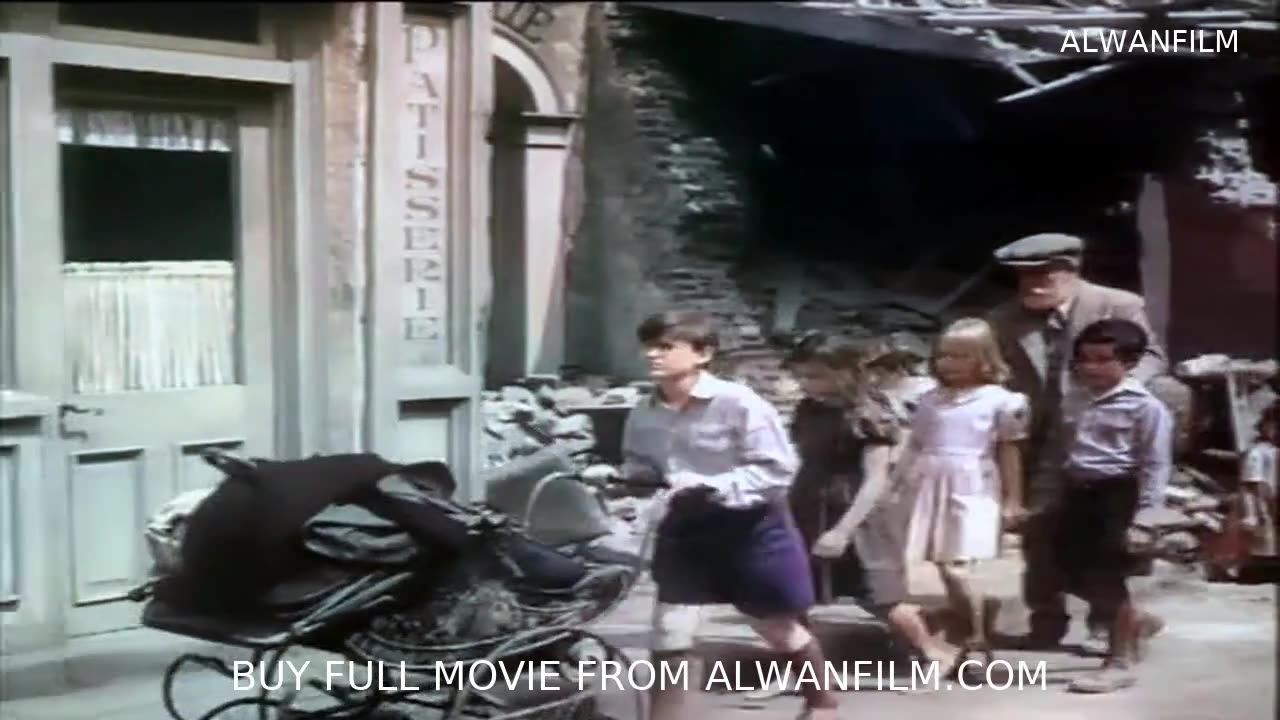Premium Only Content

The Pied Piper Colorized
The Pied Piper Colorized
Introduction
In the annals of cinematic history, "The Pied Piper 1942" occupies a unique and revered position. Directed by Irving Pichel, this adaptation of Nevil Shute's novel presents a poignant and compelling narrative set against the backdrop of World War II. Recently, the film has been re-released in an early colored version, sparking debates among film enthusiasts and critics alike. This article delves into the impact of this colorization on the viewing experience and its broader significance in film history.
Check Our YouTube Channel
https://www.youtube.com/@AlwanFilm
Understanding The Pied Piper 1942 Colorized: Director, Cast, and Genre
"The Pied Piper 1942" is a testament to the directorial prowess of Irving Pichel, who skillfully brings Shute's narrative to life. The film features a stellar cast, including Monty Woolley as the gruff yet kind-hearted Englishman, Howard, and Roddy McDowall as the resilient young boy, Ronnie. Set during the tumultuous times of World War II, the film seamlessly blends drama, suspense, and a touch of whimsy, making it a genre-defying classic.
Pichel’s vision for "The Pied Piper 1942" is one of human resilience and compassion amidst the horrors of war. His directorial approach emphasizes character development and emotional depth, ensuring that the film resonates deeply with audiences. The genre, a mix of war drama and adventure, provides a compelling backdrop for the characters' transformative journeys.
Exploring the World of The Pied Piper 1942 Colorized: Plot and Characters
The story of "The Pied Piper 1942" revolves around an elderly Englishman named Howard who, during a vacation in France, finds himself unexpectedly responsible for a group of children fleeing the advancing Nazi forces. As he leads them to safety, Howard's initially reluctant role as a guardian evolves into a mission of bravery and sacrifice.
Howard's journey is marked by numerous encounters that test his resolve and ingenuity. From narrow escapes from German patrols to navigating the treacherous terrain of war-torn Europe, each moment is fraught with tension and emotional weight. The children, each with their distinct personalities and backstories, add depth and complexity to the narrative, making the film a rich tapestry of human experience.
The Art of Film Colorization
Film colorization, the process of adding color to black-and-white footage, has long been a subject of contention within the cinematic community. Proponents argue that it revitalizes classic films for contemporary audiences, while detractors raise concerns about its impact on the original artistic vision and historical authenticity.
The colorization of "The Pied Piper 1942" represents a complex interplay of art and technology. The process involves meticulous attention to detail, ensuring that colors are not only aesthetically pleasing but also true to the period and mood of the film. When executed well, colorization can enhance the emotional and visual impact of a film, making it accessible to new generations of viewers.
Early Colored Films: A Brief History
The emergence of early colored techniques in cinema marked a pivotal moment in the industry's evolution, paving the way for future innovations in visual storytelling. From hand-painted frames to early experiments with tinting and toning, filmmakers have continuously pushed the boundaries of creativity and technology.
Early colored films offered audiences a glimpse into worlds previously unseen, expanding the possibilities of cinematic expression. From the vibrant hues of silent epics to the lush palettes of early Technicolor musicals, colorization opened up new avenues for storytelling and spectacle. However, it also presented challenges in terms of production costs, technical limitations, and artistic integrity.
The Pied Piper 1942 and Its Early Colored Version
The decision to release "The Pied Piper 1942" in a colorized format represents a bold artistic choice, inviting viewers to experience Pichel's masterpiece through a new lens. While purists may lament the alteration of the original black-and-white aesthetic, others find value in this reinterpretation, highlighting previously unseen details and nuances.
The early colored version of "The Pied Piper 1942" offers a fresh perspective on Pichel's visual storytelling, enriching the film's historical tapestry with vibrant hues and atmospheric textures. From the verdant French countryside to the somber hues of wartime Europe, colorization adds another layer of depth to the film's narrative canvas.
The Debate Over Film Colorization
As with any controversial artistic endeavor, the colorization of classic films sparks heated debates within the film community. While some argue for preservation and fidelity to the director's intent, others advocate for creative experimentation and accessibility to modern audiences. Ultimately, the debate underscores the complex interplay between tradition and innovation in cinema.
The controversy surrounding film colorization reflects broader tensions within the industry between preservation and progress. While purists may decry any deviation from the original black-and-white aesthetic, others see colorization as a means of breathing new life into classic films for contemporary viewers. As technology continues to advance, the boundaries between art and commerce become increasingly blurred, raising questions about the future of cinematic preservation and interpretation.
Examining The Pied Piper 1942 as an Early Colored Film
Viewing "The Pied Piper 1942" in its early colored incarnation offers a unique perspective on Pichel's visual storytelling prowess. From the vibrant hues of wartime Europe to the subtle nuances of character expression, colorization adds another layer of depth to the film's narrative tapestry. However, it also raises questions about the balance between artistic reinterpretation and historical authenticity.
For some viewers, the early colored version of "The Pied Piper 1942" may enhance their appreciation of Pichel's masterwork, providing a fresh interpretation of familiar scenes and themes. For others, it may detract from the film's original aesthetic and emotional impact, obscuring the stark beauty of its black-and-white imagery. Ultimately, the decision to embrace or reject colorization is a matter of personal preference, reflecting the diverse perspectives within the cinematic community.
Influence and Legacy: The Pied Piper 1942 Colorized's Impact on Cinema
Beyond its immediate impact, "The Pied Piper 1942" has left an indelible mark on the cinematic landscape, inspiring generations of filmmakers and artists. From its influence on war dramas to its lasting legacy in classic cinema, Pichel's masterpiece continues to resonate with audiences worldwide.
Pichel’s bold exploration of human resilience and compassion in "The Pied Piper 1942" has reverberated throughout the annals of cinematic history, inspiring countless filmmakers to push the boundaries of storytelling and expression. From Steven Spielberg's "Schindler's List" to Roberto Benigni's "Life is Beautiful," the influence of Pichel’s work can be felt in the narratives of war and survival, underscoring the enduring power of his cinematic vision.
Director's Cinematic Legacy: Beyond The Pied Piper 1942 Colorized
Irving Pichel's cinematic legacy extends far beyond "The Pied Piper 1942," encompassing a diverse body of work that transcends genre and convention. His profound insights into the human condition, coupled with his mastery of visual storytelling, cement his status as one of cinema's most revered auteurs.
From the suspenseful thrills of "The Most Dangerous Game" to the haunting beauty of "Destination Moon," Pichel's films continue to captivate and confound audiences with their narrative richness and visual splendor. His oeuvre reflects a commitment to exploring the deepest recesses of the human soul, grappling with questions of existence, identity, and transcendence.
Themes Explored in The Pied Piper 1942 Colorized
At its core, "The Pied Piper 1942" grapples with themes of resilience, compassion, and sacrifice, painting a poignant portrait of the human experience during wartime. Through Howard's journey, Pichel invites viewers to confront the complexities of existence and the eternal struggle for meaning in an indifferent world.
The film's exploration of heroism and humanity resonates with audiences on a visceral level, tapping into universal truths about the human condition. From Howard's reluctant transformation into a guardian and protector to the children’s unwavering trust and bravery, the film offers a profound meditation on the nature of belief, sacrifice, and redemption.
Reception and Controversy Surrounding The Pied Piper 1942 Colorized
The release of "The Pied Piper 1942" in its early colored version has sparked both acclaim and controversy among critics and audiences. While some praise the newfound vibrancy and depth, others lament the departure from the film's original aesthetic. Nevertheless, the debate underscores the enduring relevance of Pichel's masterpiece in contemporary discourse.
Critics have praised the film's visual beauty, thematic richness, and emotional resonance, hailing it as a towering achievement in cinematic art. However, others have raised concerns about the impact of colorization on the film's integrity, arguing that it detracts from Pichel’s original vision.
Where to Watch The Pied Piper 1942 Colorized Online
For those eager to experience the timeless brilliance of "The Pied Piper 1942," the film is available on various streaming platforms, ensuring accessibility to audiences worldwide. Whether in its original black-and-white format or the early colored rendition, Pichel's opus remains essential viewing for cinephiles and newcomers alike.
FAQs About The Pied Piper 1942 Colorized
Common queries surrounding "The Pied Piper 1942" range from its historical accuracy to its thematic resonance in modern times. By addressing these frequently asked questions, viewers can gain a deeper understanding of the film's enduring appeal and cultural significance.
Q: Is "The Pied Piper 1942" historically accurate?
A: While the film is inspired by events during World War II, it takes artistic liberties with historical events and characters. Pichel's primary focus is not on strict historical accuracy but on exploring timeless themes of resilience, compassion, and humanity.
Q: What is the significance of the film's title?
A: The title "The Pied Piper" alludes to the legendary German tale of the Pied Piper of Hamelin, who led children away from danger. In the film, Howard embodies this role, leading children to safety amidst the chaos of war.
Q: What is the symbolism of the film's imagery?
A: The imagery in "The Pied Piper 1942" is rich with symbolism, reflecting Pichel's deep spiritual and philosophical concerns. From the recurring motif of the journey to the contrasting landscapes of war and peace, each image carries multiple layers of meaning, inviting viewers to contemplate the mysteries of existence.
Conclusion
In conclusion, "The Pied Piper 1942" stands as a towering achievement in cinematic history, its legacy enduring through the ages. While the early colored version offers a fresh perspective on Pichel's masterwork, purists may still prefer the original black-and-white presentation. Regardless of personal preference, one thing remains clear: the power of "The Pied Piper 1942" lies not in its color palette but in its profound exploration of the human spirit and the eternal quest for meaning and compassion. As we continue to grapple with the ever-evolving landscape of cinema, let us heed the lessons of Pichel's masterpiece and strive to honor his visionary legacy for generations to come.
-
 1:00
1:00
AlwanFilm
6 days agoA Foreign Affair (1948) Colorized
45 -

FreshandFit
6 hours agoAfter Hours w/ Girls
219K81 -
 2:33:36
2:33:36
Badlands Media
7 hours agoOnlyLands Ep. 21: From Trump’s VP Pick to Green Energy Grift
57.7K6 -
 1:07:26
1:07:26
Inverted World Live
10 hours agoThe War Against Robots w/ Joe Allen
90.9K4 -
 6:08:31
6:08:31
SpartakusLIVE
10 hours agoWARZONE NUKE IS BACK?! || Solo Challenge CHAMPION to start, duos w/ the Dawg later
92.1K -
 1:00:18
1:00:18
Man in America
12 hours agoBig Pharma’s Empire of Lies Is COLLAPSING as People Turn to Natural Medicine
56K20 -
 LIVE
LIVE
Drew Hernandez
14 hours agoGHISLAINE MAXWELL SAYS CLAIMS EPSTEIN WAS INTELLIGENCE ASSET ARE BULLSH*T?!
805 watching -
 29:54
29:54
Afshin Rattansi's Going Underground
21 hours agoUkraine: Prof. Anatol Lieven SLAMS Europe’s ‘BLOODY STUPIDITY’ as Trump Negotiates with Putin
31K6 -
 15:27
15:27
robbijan
1 day ago $2.45 earnedThe Emperor’s New Labubu & The Spiritual War Behind Everything
52.4K43 -
 LIVE
LIVE
GritsGG
19 hours ago36 Hour Stream! Most Wins 3420+ 🧠
875 watching